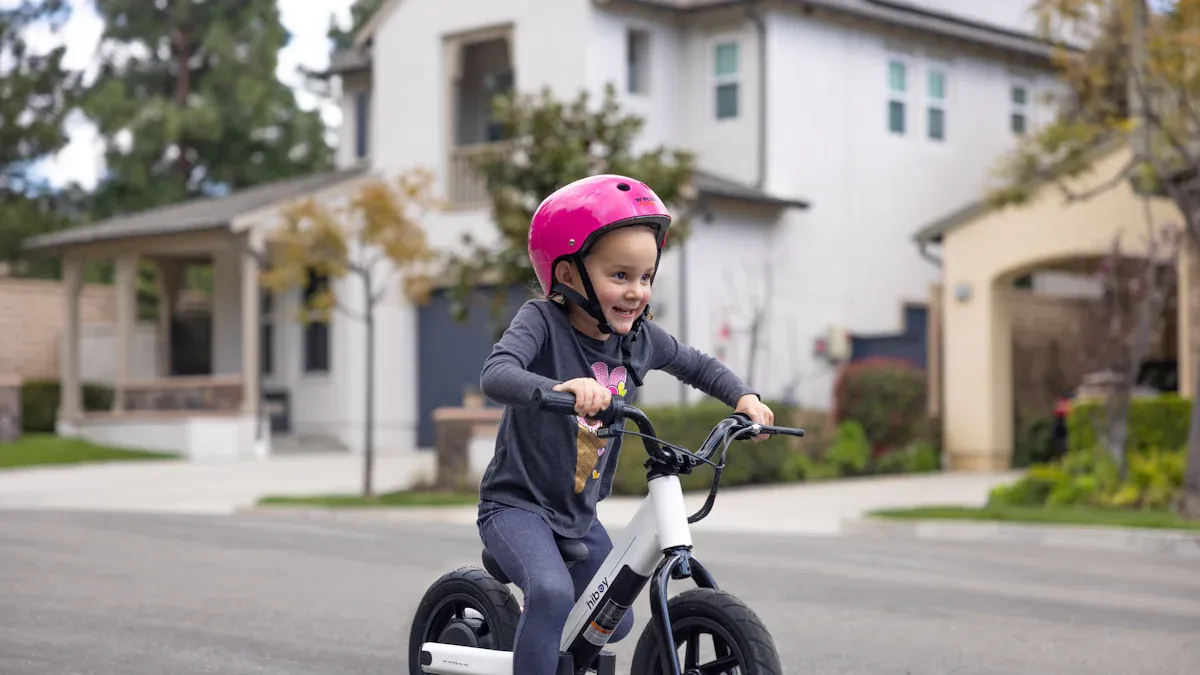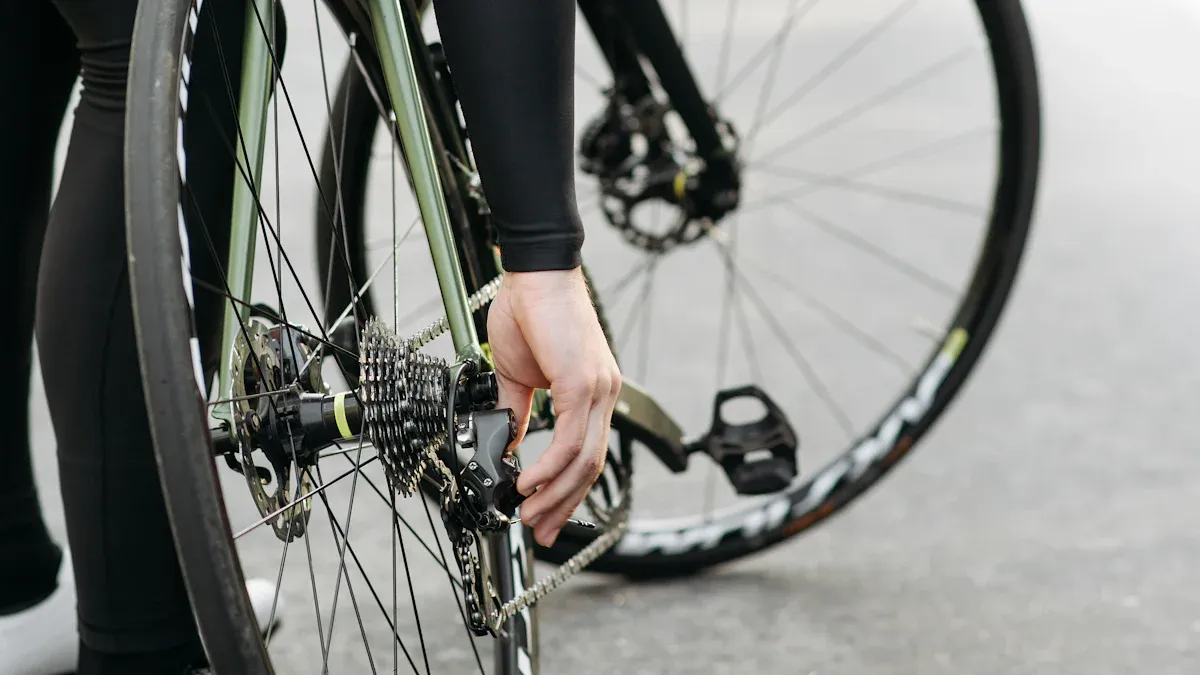
Riding a small frame road bike can be a blast, but safety and comfort are key. You want to enjoy your ride without worrying about injuries. A proper bike fit for your small frame road bike makes a huge difference. It aligns your body with the bike, reducing strain on your joints and muscles. This helps prevent common issues like knee pain and back pain. So, take the time to adjust your small frame road bike for a better experience!
Key Takeaways
Pick the right bike size by measuring your inseam. Adjust your seat height to avoid pain and feel comfortable.
Wear a helmet that fits well. Use bright, reflective clothes and lights to stay safe and seen on the road.
Use good riding skills like looking ahead. Keep a balanced stance. Signal clearly and check your brakes before each ride.
Bike Fit

Getting the right bike fit is crucial for your safety and comfort when riding a small frame road bike. A well-fitted bike helps you maintain a comfortable riding position, reducing the risk of injuries and enhancing your overall experience. Let’s dive into how you can measure your frame size and adjust your seat height for the perfect fit.
Measuring Frame Size
To find the right size bike for you, start by measuring your inseam. Here’s how to do it:
Stand on a hard surface with your feet about 6-8 inches apart.
Place a book or a ruler firmly between your legs, simulating the position of sitting on a saddle.
Make sure the book or ruler is level and measure from its top to the floor.
Use manufacturer size charts that correlate your height and inseam to recommended frame sizes as a starting point.
Consider test rides and professional fitting services for precise fit and comfort.
Choosing the right size bike is essential. Riding a bike that’s too small can lead to discomfort and pain. You might find pressure on the wrong body parts, which can cause issues like wrist soreness and back pain. Additionally, a smaller frame can make it harder to maintain balance and control, which increases the risk of accidents.
Adjusting Seat Height
Once you’ve found the right size bike, it’s time to adjust your seat height. Proper seat height is vital for knee and back health. Here are some guidelines to help you get it just right:
Measure your current seat height from the bottom bracket center to the top of the seat using a tape measure.
Calculate your ideal seat height by multiplying your inseam length by 1.09 for road bikes. For mountain bikes, subtract 1-2 cm for better control.
Loosen the seat clamp with the appropriate tools, like Allen keys or an adjustable wrench.
Adjust the seat height, ensuring the seat post remains above the minimum insertion mark for safety.
Tighten the seat clamp securely, preferably using a torque wrench to avoid over-tightening.
Check your comfort by sitting on the bike and placing your heel on the pedal at the lowest point. Your leg should be fully extended without any hip rocking.
Adjust the seat tilt and fore/aft position to optimize comfort and power transfer.
Remember, even small adjustments can make a big difference. If your seat is too low, it can increase knee flexion at the top of the pedal stroke, stressing your quadriceps and causing pain. On the other hand, a seat that’s too high can strain your hamstrings and lead to discomfort behind the knee.
By taking the time to ensure your bike fit is correct, you’ll enjoy a more comfortable ride and reduce the risk of injuries. If you’re unsure about your adjustments, don’t hesitate to seek professional help. A bike that fits you well will make all the difference in your cycling experience!
Safety Gear

When you ride a small frame road bike, wearing the right safety gear is very important. It keeps you safe and makes your ride better. Let’s look at two key parts of safety gear: helmets and visibility gear.
Choosing a Helmet
A helmet is the most important safety gear you can wear. It protects your head from injuries if you fall or have an accident. Here are some important things to think about when picking a helmet:
Fit: Measure your head about an inch above your eyebrows and ears. Use a flexible tape measure and check a helmet size chart to find the right size. Look for helmets with adjustable straps for a good fit.
Certification: Make sure your helmet meets safety rules. In the U.S., check for the CPSC sticker, which shows it passed safety tests. Helmets with MIPS technology give extra protection against twisting forces.
Ventilation: Good airflow keeps you cool while riding. Choose a helmet with enough vents to stay comfortable.
Design: A compact design works best for smaller heads. Make sure the helmet sits level on your head, covering your forehead without tilting.
Wearing a helmet can greatly lower the chance of serious injuries. Studies show that helmets can reduce skull fractures by about 65% to 80%. This shows how important it is to wear a helmet, especially for small frame bike riders who might be more at risk in an accident.
Visibility Gear
Visibility gear is very important for staying safe on the road. It helps drivers see you, especially when it’s dark. Here are some good visibility gear options:
Bright Clothing: Wear bright and reflective clothes, like neon jackets or vests. These colors stand out and help drivers notice you.
Reflective Accessories: Put reflective tape or stickers on your bike and gear. This extra visibility can help catch drivers’ attention, especially at night.
Lights: Put bright LED lights on your bike. Use front and back lights, and think about flashing lights to get noticed. Riding with your lights on during the day can also help you be seen.
Proper Lane Positioning: Stay in a safe spot in the lane to avoid blind spots. Use hand signals to show what you plan to do.
Research shows that bright colors improve visibility, but they work best with good lighting. Reflective materials are most effective when light shines on them, so make sure you have both reflective gear and lights for the best safety.
By getting good safety gear, you can enjoy your rides on a small frame road bike with more peace of mind. Remember, safety is not just about protecting yourself; it’s also about being seen and being aware of what’s around you.
Riding Techniques
Riding a small frame bike needs special techniques for safety and comfort. Here are some tips to help you stay in control and ride safely in traffic.
Maintaining Control
To keep your bike steady, use these techniques:
Look Ahead: Always check the road or trail in front of you. This helps you stay smooth and in control.
Balanced Stance: Keep your knees bent, feet flat on the pedals, and elbows relaxed. This position helps you stay stable.
Light Grip: Hold the handlebars gently. A relaxed grip helps you feel better and stops oversteering.
Consistent Cadence: Keep a steady pedaling rhythm. This helps you keep moving and stay balanced.
Weight Distribution: Center your weight on the bike. This improves balance and how quickly you respond.
Practicing these techniques often will make you a better rider. Doing exercises like yoga off the bike can also help your balance, making you feel more confident.
Navigating Traffic
When riding in traffic, safety is very important. Here are some strategies to help you stay safe:
Ride Predictably: Always go with the flow of traffic. Avoid sudden moves that might confuse drivers.
Signal Clearly: Use hand signals to show what you plan to do. Signal early so drivers have time to react.
Stay Visible: Wear bright clothes and use lights, especially when it’s dark. Make eye contact with drivers to make sure they see you.
Avoid Blind Spots: Stay out of the blind spots of big vehicles. Position yourself where drivers can see you well.
Scan for Hazards: Always check your surroundings. Look for obstacles, parked cars, and other people on the road.
By using these techniques, you can ride safely and confidently while enjoying your small frame bike.
Maintenance Tips
Taking care of your small frame bike is very important for safety and to make it last longer. Regular maintenance helps you avoid problems and makes your ride smoother. Here are some important tasks you should do to keep your bike in great shape.
Inspecting Brakes
Your brakes are very important for safety, so check them often. Here’s a quick list to follow:
Inspect Brake Pads: Look for wear. If they are too thin or worn unevenly, replace them.
Check Cables: Look for fraying or rust. If you see any damage, replace them.
Examine Rotors: For disc brakes, make sure they are smooth and even. Warping or grooves can affect how well they work.
Clean Surfaces: Use the right cleaners to keep braking surfaces free from oil and dirt.
Adjust Tension: Use barrel adjusters to make sure your brakes work properly.
Testing your brakes before each ride is a smart idea. Spin the wheels and apply the brakes to make sure they stop smoothly without dragging.
Chain Care
A well-kept chain helps your bike run well. Here’s how to take care of it:
Lubricate After Rides: Put lubricant on at the end of your ride. This lets it soak into the rollers.
Clean Regularly: Use bike-specific cleaners to remove dirt and grime. This helps prevent wear on the chain and cassette.
Monitor Wear: Check for elongation. Replace the chain when it reaches 0.5% to 0.8% elongation to avoid damaging other parts.
Apply Lubricant Properly: Focus on getting lube inside the rollers and between plates, not just on the outside.
Regular chain care can cut friction by up to 50%, making your ride better and helping your drivetrain last longer. By keeping your brakes and chain in good shape, you’ll enjoy safer and smoother rides on your small frame bike!
To sum up, having the right bike fit, safety gear, and riding skills is important for enjoying your small frame bike. Here are some main points to remember:
Keep a good posture to stay comfortable.
Change your saddle height for the best leg stretch.
Use important safety gear like helmets and padded shorts.
If you are worried about your bike setup or riding skills, think about getting professional help. It can really improve your cycling experience! 🚴♂️
FAQ
What size bike frame do I need?
You need to measure your inseam and refer to size charts. A professional fitting can help ensure the best fit.
How often should I check my bike’s brakes?
Check your brakes before every ride. Regular inspections keep you safe and ensure they function properly.
Can I ride a small frame bike if I’m tall?
Yes, but it may require adjustments. Consider a professional fitting to optimize comfort and performance. 🚴♀️
See Also
Simple Guidelines To Fit Your Bike Frame Comfortably
Must-Know Tips To Safeguard Your Bike Frame Properly
Mountain Bikers Share Unexpected Advantages Of Small Frames
